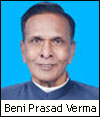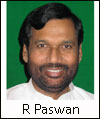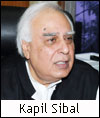The Indian telecom industry has undergone revolutionary change during the past few years to become one of the leading markets in the world. Along with a high growth rate, scandals have been part and parcel of this industry, especially at the ministerial level. Former telecom minister Sukh Ram was proven guilty of a scam worth Rs 1,500 crore which involved a telecom equipment contract being awarded to a private firm.
Pramod Mahajan, another former telecom minister, was alleged to have favoured Reliance Infocomm. On the other hand, Ram Vilas Paswan had been accused of a Rs 13,000 crore scam involving the issue of telecom licences. The latest and most talked about scandal is the ‘2G license scam’ during A Raja’s tenure.
A Raja is adamant that he is not at fault and that he only followed the national telecom policy of 1999, the same that his predecessors had followed. So, what exactly did his predecessors do? Telecom Yatra takes a look at what all the telecom ministers before Raja did, starting from the year 1991.
Sukh Ram (1991-1996)Although the minister is credited with unleashing the communication revolution in the country, he was accused of being involved in a scandal worth Rs 1,500 crore. When Sukh Ram took over, 40 lakh people were on the waiting list for a BSNL telephone connection with waiting periods stretching from one to ten years. Sukh Ram invited MNCs to introduce the latest technology in the country, thus ending the long waiting list and ushering in an era of mobile telephony in India.
However, he was charged with corruption during his tenure and was convicted and sentenced to three years’ imprisonment for amassing assets worth of Rs 4.25 crore.
He was also accused of taking money for awarding telecom equipment contracts worth more than Rs 20,000 crore.
It was under him that the National Telecom Policy of 1994 was formulated, which envisaged the bidding process to sell spectrum, and licenses, to operators for telephony services.
The bill was controversial as it effectively blocked out the participation of Indian companies in the basic telephones tender by declaring that only firms with experience of laying down one lakh lines could apply.
Additionally, not all Indian companies were kept out by the bill. Companies which had foreign partners with 49 per cent equity were deemed eligible. Even subsidiaries of foreign companies with 10 per cent equity could bid, a further rider added.
Significantly, no Indian public sector company was allowed to bid. This LED to much criticism and the government had to declare on May 27, 1995 that PSUs could apply with equity participation from the private sector.
Sixteen companies submitted their tenders for 21 telecom circles. The highest bidder was Himachal Futuristic Communications Ltd (HFCL) along with Israeli company Bezeq and a Thai company called Shinawatra. They bid Rs 85,000 crore for license to operate in nine circles. This was about five times higher than what the Tatas, Ambanis, the RPG group and other players had to offer.
The government had put no cap on the number of circles one company could bid for, and the mindboggling amount of Rs 85,925 crore for providing basic services in nine telecom circles was offered by HFCL, which took the entire business community by surprise. Soon, there was talk of a deal between the company and the telecom minister.
It is alleged that as part of this deal, Sukh Ram imposed a cap of three circles for providing cellular and basic services in circles of category A and B. And in case of basic services, the highest bidder would be allowed to choose the three circles it wanted to operate in.
At that time, a lot of companies and their foreign telecommunications partners participated in bidding for the right to offer basic (wire line) telephony in India.
Companies that bid included multinationals such as AT&T, US West, Bell Atlantic, Nynex, NTT and Bell Canada, and small telcos such as Bezeq of Israel, and Shinawatra of Thailand. Their Indian partners included the Tatas, Birlas, RPG, Reliance, BPL, Essar, Shyam Telecom and Himachal Futuristic Communications Limited (HFCL).
The privatisation process, however, got stalled and it was only after the next government took over that the bidding process was completed and the private players started services in 1996. Beni Prasad Verma (1996-1998)It was under Verma that the bidding process was completed. TRAI was also formulated during his tenure.
Beni Prasad Verma (1996-1998)It was under Verma that the bidding process was completed. TRAI was also formulated during his tenure.
During Verma’s tenure Bell Canada and Swisscom had withdrawn from the Indian market and American companies such as AT&T and US West had frozen fresh investments blaming “unfriendly telecom policies”, particularly high license fee outflows and the lack of a powerful regulator.
Moreover, many South East Asian telecom operators also pulled out after 1996 in the aftermath of the South East Asian currency crisis, which reduced their ability to invest in other countries.
Verma, during his tenure, also handed out additional spectrum of 1.8 MHz to cellular operators in various circles without any upfront payment.
As a result, the exchequer got only the license fee share, but some operators delayed the launch and the government lost revenues because of this.
Jagmohan (1998-1999)In 1999 when Jagmohan took over the reins of the ministry, telcos owed Rs 3,500 crore as licence fee. The cellular telephone industry was posting losses worth $92 million every month, but Jagmohan was not willing to relent on his demand that telcos should pay their dues.
He was soon transferred to the Urban Development ministry. The portfolio was taken over by the prime minister A B Vajpayee. Ram Vilas Paswan (1999-2001)Vajpayee appointed Ram Vilas Paswan as his minister of state. To help the industry come out of trouble, they together oversaw the formulation of the New Telecom Policy of 1999. The earlier practice of a fixed licence fee was replaced by a revenue sharing agreement.
Ram Vilas Paswan (1999-2001)Vajpayee appointed Ram Vilas Paswan as his minister of state. To help the industry come out of trouble, they together oversaw the formulation of the New Telecom Policy of 1999. The earlier practice of a fixed licence fee was replaced by a revenue sharing agreement.
Reliance Infocomm was allowed to offer full nationwide mobility. Paswan was alleged to have been involved in a Rs 1,300 crore scam in giving out licenses to GSM and CDMA players.
While territories were sold out to respective licensees through cellular service providers with the allotment of a Frequency of 6.2 MHz, realising about Rs 740,000 crore for the government, the same government provided basic service support through CDMA WLL technology at a higher frequency of 12.5 Mhz.
Pramod Mahajan (2001-2003)Pramod Mahajan succeeded to the post in August 2001 under controversial circumstances. He was tasked with implementing NTP 1999. Explosive growth in the mobile subscriber base was triggered in his time. Telecom companies saved thousands of crores of rupees in waived fees.
Mahajan was removed from the telecom ministry after the controversies over privatisation of Videsh Sanchar Nigam Limited (VSNL). According to rumours, he managed to amass an estimated Rs 2,500 crore as his share of the spoils. He also allegedly dolled out undue favours to Reliance Communications.
Arun Shourie (2003-2005)He approved the grant of united access service licences on a first come, first served basis.
Shourie pointed to the telecom regulator’s recommendation and Paswan’s policy. He too was accused of devouring certain players. Dayanidhi Maran (2005-2007)He was the one minister who did not court many controversies. He was liked by both, the industry as well as by consumers. He helped to lower call rates to rock bottom. He was also working toward reducing duty rates for the industry as well as making spectrum available by asking the defence to vacate spectrum. However, he had to exit in compliance with his party’s wishes.
Dayanidhi Maran (2005-2007)He was the one minister who did not court many controversies. He was liked by both, the industry as well as by consumers. He helped to lower call rates to rock bottom. He was also working toward reducing duty rates for the industry as well as making spectrum available by asking the defence to vacate spectrum. However, he had to exit in compliance with his party’s wishes. A Raja (2007-2010)Raja gave out licences to new operators in 2008 at a rate fixed in 2001. Under him, DoT gave licences without the Cabinet approving the first come first served condition. It is alleged that the cut-off date for applying was revised from October 1 to September 25 to favour certain players.
A Raja (2007-2010)Raja gave out licences to new operators in 2008 at a rate fixed in 2001. Under him, DoT gave licences without the Cabinet approving the first come first served condition. It is alleged that the cut-off date for applying was revised from October 1 to September 25 to favour certain players.
Some allegations against A RajaHe is accused of favouring real estate companies such as Swan and Unitech. Swan got a licence for Rs 1,537 crore and within weeks offloaded 45 per cent of its shares to UAE-based Etisalat for Rs 4,500 crore.
Unitech got a licence for Rs 1,650 crore and also offloaded 60 per cent stake to Norwegian company Telenor for Rs 6,200 crore. As Telenor is operating in Pakistan and Bangladesh, the Home Ministry raised objections.Raja had also ordered BSNL to enter an unprecedented Intra-Circle Roaming Agreement with Swan. This was done just a few days before the Etisalat deal. This deal with BSNL helped Swan boost its share price.
It is alleged that the move by Raja caused a loss of more than Rs 160,000 crore to the state exchequer. Kapil Sibal (2010-onward)Sibal has been given the charge of the ministry after A Raja tendered his resignation.
Kapil Sibal (2010-onward)Sibal has been given the charge of the ministry after A Raja tendered his resignation.

